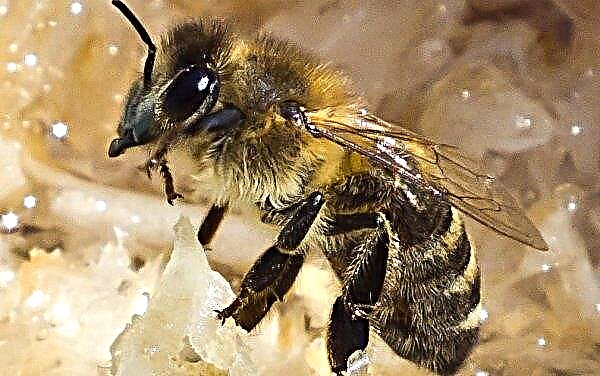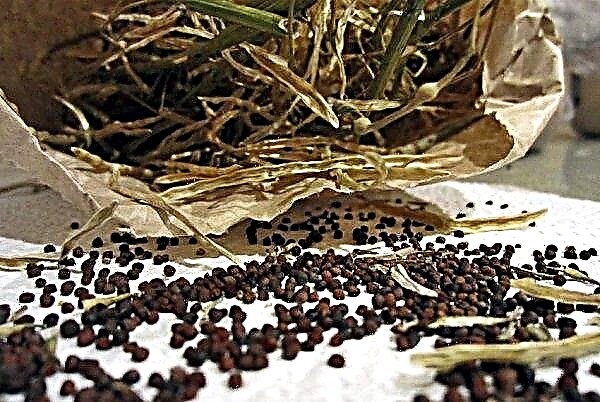Violet (Saintpaulia) - a classic among indoor flowering plants. If your collection of home flowers has not yet been replenished with a violet or there are problems with the cultivation of this plant, we recommend that you pay attention to the information given in the article.
Description of flowers
Violet is a low perennial herbaceous plant that has a main shortened stalk with numerous pubescent leaves planted on long petioles.
Varieties used to obtain new interesting specimens are grouped according to the shape of the flowers, among which are:
- fringed;
- terry;
- simple;
- ampelous.
 The bloom of the senpolia can be either one color (pink, red, white, blue), or several (with a different combination of shades of these colors and patterns). Violet buds are small in size, usually their diameter reaches 3 cm.
The bloom of the senpolia can be either one color (pink, red, white, blue), or several (with a different combination of shades of these colors and patterns). Violet buds are small in size, usually their diameter reaches 3 cm.Hybrid varieties of senpolia can have larger flowers, up to 8 cm in diameter, which cover the plant abundantly during flowering (more than 70 flowers may appear on 1 specimen). Petals of some varieties can have a border, spots, dots, stripes of various shades.
Did you know? Violets are used in folk medicine, some types of this plant help treat kidney diseases, whooping cough, bronchitis and dermatitis.
Leaves, depending on the type of plant, can be heart-shaped, rounded or oval in shape, with solid or serrated edges. Color can also be different: from light green to dark green, with patterns (border, spots, stains) of white, red, gray colors.
The sheet plate is densely covered with short villi, which create a “velvety” surface.
The basic rules for growing violets on the windowsill
In order for the senpolis to please you with a long and magnificent flowering, in the process of growing, observe the basic rules:
- create comfortable conditions and necessary microclimate indicators in the room;
- comply with care recommendations;
- timely preventive treatment of common diseases;
- regularly inspect the plant for pests or diseases and take measures to cure;
- trimming old leaves in time to preserve the decorative look and better nutrition of young leaves;
- after 2-3 years of life, the plants are rejuvenated (using a cuttings or rosettes of several young leaves).

Caring for violets on the windowsill
For the normal growth of the green part, the abundant formation of buds and long flowering, the senpolia needs to create suitable growing conditions, as well as quality care, therefore, we will consider this information in more detail.
Optimal conditions
Depending on the time of the year, the temperature in the room should have certain indicators: in winter, the range +18 ... + 20 ° C is considered to be a suitable temperature for senpolia, in the summer +20 ... + 25 ° C. Humidity, regardless of the season, must be maintained at 50%.
Important! The plant reacts very poorly to cold or constant drafts, so only insulated window sills are suitable for growing violets in winter, otherwise the flower is rearranged to a warmer place.
The bloom of the senpolia is year-round, so the lighting should be good both in summer and in winter. To preserve flowering in winter, Saintpaulia is illuminated with fluorescent lamps to extend daylight hours to 10 hours a day, and if possible, then to 12.
The flower prefers to grow on well-lit window sills of the western or eastern direction, it is possible to grow on the southern window, but subject to shading from direct sunlight.
Watering mode
You need to water the violets with high-quality soft, settled water at room temperature. It is better to add water to the pan, but you can also add it to the root, being careful not to get on the green part of the plant or flowers. If water regularly falls into the center of the leaf outlet, the flower may rot and die. When watering into the pan, excess water is drained after 15 minutes to avoid decay of the root system due to constant overmoistening of the lower soil layer. In summer, violet is watered daily with a small amount of water, and in winter - 2 times a week.
When watering into the pan, excess water is drained after 15 minutes to avoid decay of the root system due to constant overmoistening of the lower soil layer. In summer, violet is watered daily with a small amount of water, and in winter - 2 times a week.
At low humidity, it is allowed to spray the Saintpaulia from the spray gun, but only during the period when there is no flowering. The flowers react very poorly to spraying, they may fade, rot or crumble.
Fertilizer application
Violets growing the first 3 months in a new nutrient soil do not require top dressing. As the soil is depleted, after a specified time, you can begin to apply fertilizers to stimulate flowering. Ready-made complex fertilizers of the same name, which are sold in flower shops, are well suited as top dressings for violets.
Depending on the manufacturer, the instructions for the preparation and use of nutritional mixtures may vary, so read the label carefully before use. Fertilizing is carried out under the root, and 2 hours before application, the soil is pre-moistened so that the fertilizer does not burn the roots of the plant.
The violet suffers from an excessive amount of top dressing, so the frequency of application of nutrient mixtures should be regulated by the grower independently. Pay attention to the appearance of the flower: if the leaves are healthy, large, flowering is regular and plentiful, rarely feed - 1-2 times in 6 months.
Plant transplant
A flower transplant can be carried out in different ways, depending on the circumstances. If an urgent transplant is required when the senpolia suffers from a large number of processes or an overgrown root system, transshipment is carried out. In the process of transshipment, a good drainage layer (3-4 cm) is poured into a new larger pot (3 cm in diameter) and the violet is transferred from the old pot with full preservation of the earthen coma.
In the process of transshipment, a good drainage layer (3-4 cm) is poured into a new larger pot (3 cm in diameter) and the violet is transferred from the old pot with full preservation of the earthen coma.
Transplantation can also be carried out with a complete replacement of the soil, if over time it is completely depleted, the root system has suffered from excess moisture or has been affected by diseases and pests. To transplant a flower, the pot is chosen the same size or slightly larger (1-2 cm in diameter).
New soil is prepared for transplantation (especially for violets). The bottom of the pot is covered with a drainage layer and a small amount of substrate.
The flower is carefully removed from the old pot and the roots are freed from the soil, which are then carefully examined for damage, rot or dead parts, and if they are found, they are carefully cut with a sharp knife and sprinkled with activated charcoal.
After this, the senpolia is set in a new pot and the voids at the roots are filled with soil, periodically shaking the container for better distribution of the earth.
The most popular is a transplant with a partial replacement of the soil. Such a transplant is performed when it is necessary to propagate the plants, separating the children, if they filled almost the entire space of the pot. Pots of small diameter (up to 5 cm) are prepared for transplantation in order to plant children in them.
The mother plant is planted in a larger pot (2 cm). The earthen lump is slightly destroyed in order to free the root system of the children and carefully separate them. All plants are set in pots with a drainage layer and filled with soil.
Trimming and shaping a socket
Pruning of violets is done in order to preserve the decorative appearance of the plant by removing old, yellowed leaves, or to form a beautiful rosette for the proper growth of leaves and flowers. An adult plant constantly releases new outlets, which over time greatly thicken the plant, so they are recommended to be cleaned in a timely manner.
You need to remove leaves or sockets completely with cuttings, a sharp clean knife. On each plant, 3 rows of younger leaves are left, and the rest, lower ones, are removed.
The violet is constantly reaching for the sun and therefore has deformed rosettes, so that the plant is symmetrical, periodically turn the pot in different directions.
From regular removal of leaves from the bottom of the plant, the central stem will be exposed and spoil the decorative look. To solve the problem, the violet is transplanted, deepening the bare part of the stem into the ground, or rejuvenation is performed.
Anti-aging pruning involves cutting the stem “under the root”, preserving the length of the exposed part of 2 cm, so that there is room for the formation of roots. The stem is set in water and waiting for the moment when the roots appear on it, then planted in the soil.
Breeding methods
The vegetative method of propagation gives a good result and allows you to relatively quickly get a beautiful plant that will bloom soon. There are 2 ways to propagate senpolia vegetatively - by leaf and by children. Let's consider them in more detail.
Kids
The easiest way to propagate Saintpaulia by children, which are formed in the form of rosettes on the mother plant. If you do not separate them in time, the flower begins to turn yellow, wither and ceases to bloom. In order to prevent such a development of events, the children are separated and planted in separate containers (5 cm in diameter).
If you do not separate them in time, the flower begins to turn yellow, wither and ceases to bloom. In order to prevent such a development of events, the children are separated and planted in separate containers (5 cm in diameter).
It is better to separate the children during transplantation, carefully untangling the roots.
Children should be planted in a special soil for violets, and pour 1 cm of expanded clay on the bottom of the pot.Important! If the roots are broken or injured during the separation of children, the plant will take root poorly, so the roots are lowered into the Kornevin solution and the pot is covered with polyethylene on top.
Leaf
When the violet is still young and does not have additional sockets (children), it is propagated by leaf. Material suitable for propagation is a young, healthy leaf from the second tier of the outlet. The leaf is cut at an angle, maintaining the length of the cuttings of 5-6 cm. The cut material is set in water and the appearance of the roots is expected.
After roots of 0.5–1 cm in length are formed on the leaf, it is planted in a substrate for violets, providing drainage (1 cm) from expanded clay. Pot choose up to 5 cm in diameter. To care for the cuttings should be the same as for an adult plant, but do not fertilize until at least one rosette of leaves appears and grows slightly.
Diseases and pests of violets
Sometimes the home senpolia is affected by diseases and pests that can appear on any part of the flower and cause a loss of decorativeness or even death of the plant.
Among the common diseases of the senpolia are:
- Powdery mildew - defeat of the terrestrial part of the flower with white bloom. The cause of the disease is problems with lighting, keeping in a cold and humid room. For treatment, the drug “Fundazole” is used, a flower is sprayed with a solution based on it, which helps to overcome the disease. The preparation of the solution and the processing of the flower should be carried out in accordance with the instructions for the drug.
- Late blight - decay of the root neck of the flower, the appearance of brown spots on the deciduous plates. The cause of the disease is regular drafts and waterlogging of the soil. It is very difficult to fight the disease, most often the affected plant dies soon after infection. You can try to save the flower by treatment with Fitosporin, according to the instructions.
- Botritis (mold) - manifests itself in the form of a fluffy gray-brown coating on leaves or cuttings. The disease has a fungal nature and develops due to improper care, high humidity and low temperature of cultivation. At the beginning of the development of the disease, it is possible to save the flower by treatment with Teldor according to the instructions. If the plant has more than 50% of the affected leaves, the probability of preserving the violet is greatly reduced.
The pests that most often affect the violet include:
- Spider mites - small insects that cause yellowing and falling of leaves. It is possible to determine that the plant was hit by a tick by the presence of a thin web on leaf plates. The reason for the appearance of insects is dry air and high temperature in the room. You can save the flower by treatment with Fitoverm, according to the instructions.
- Thrips - small insects that infect leaves and cuttings. To overcome the pest, apply "Actellik", according to the instructions.
- Mealybug - a pest that settles in the soil and feeds on the sap of the plant. You can only detect a worm when transplanting a plant. With a large number of pests, the plant begins to turn yellow and wilt. You can overcome the mealybug by treating the Aktara plant according to the instructions.

How to place the violet on the window: signs
There are many superstitions about growing violets in an apartment, so if you believe in signs, it’s best to familiarize yourself with the information below before buying a flower:
- There is an opinion that violets are not suitable for growing by single people, since these flowers destroy personal life (the probability of meeting a soul mate is reduced). For couples, on the contrary, violet brings happiness in family life, harmony and strengthens feelings.
- Often you can find information that you can not hold violets in the bedroom. Consider why. The fact is that the violet produces oxygen only in the daytime, and at night it consumes and produces carbon dioxide, so often, waking up in the morning, a person feels weakness and a headache.
- Despite some negative effect of violets, it strengthens the immune system well, therefore it is recommended for placement in a children's room (but is taken out to a room where people do not sleep at night). Violet also brings prosperity and prosperity to the house. Its smell repels ants and other insects.
Did you know? In ancient Greece, violet was considered the flower of death and sorrow; therefore, it adorned the mortal bed and graves.
To get a positive effect from growing violets at home, you need to know which window is better to put a flower on. The plant is called an energy vampire, but if you put the pot on a well-lit window sill, the plant will be fed by solar energy, not human. Thus, violet is an unpretentious, beautifully flowering plant and is well suited for growing on a windowsill. In order for the violet bloom to be long and plentiful, it is necessary to follow the basic recommendations for caring for it and for placing it in the apartment.
Thus, violet is an unpretentious, beautifully flowering plant and is well suited for growing on a windowsill. In order for the violet bloom to be long and plentiful, it is necessary to follow the basic recommendations for caring for it and for placing it in the apartment.












